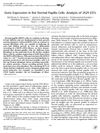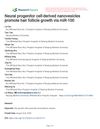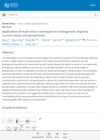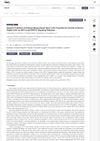TLDR Annexin A2 isoform 2 helps dermal papillae cells grow, affecting hair growth.
The study investigated the role of Annexin A2 isoform 2 in the growth of dermal papillae cells (DPC), which are crucial for hair growth. Using RT-PCR and Western blot, it was found that Annexin A2 isoform 2 was up-regulated in early passage DPC (passage 3) compared to later passage DPC (passage 10). Suppressing Annexin A2 isoform 2 with siRNA in passage 3 DPC reduced their proliferation, while over-expressing it in passage 10 DPC increased their proliferation. These findings suggested that Annexin A2 isoform 2 played a role in regulating DPC proliferation and might be linked to the hair follicle growth cycle.
 87 citations
,
April 2018 in “Biochemical and Biophysical Research Communications”
87 citations
,
April 2018 in “Biochemical and Biophysical Research Communications” Exosomes from dermal papilla cells can help grow hair and might treat hair loss.
5 citations
,
August 2005 in “Archives of Dermatological Research” HSPC016 gene is important for hair growth.
32 citations
,
February 2002 in “Veterinary Dermatology” Canine dermal papilla cells and fibroblasts have distinct growth patterns and protein expressions.
 14 citations
,
October 2000 in “Genomics”
14 citations
,
October 2000 in “Genomics” Rat dermal papilla cells have unique genes crucial for hair growth.
27 citations
,
December 1997 in “Archives of Dermatological Research” Rat dermal papilla cells have unique properties and interact differently with their environment compared to other skin cells.
106 citations
,
April 1986 in “British Journal of Dermatology” Dermal papilla cells from human hair follicles form unique structures and don't live as long as other skin cells in lab conditions.
29 citations
,
January 2021 in “Journal of nanobiotechnology” Tiny particles from brain cells help hair grow by targeting a specific hair growth pathway.
 August 2020 in “Research Square (Research Square)”
August 2020 in “Research Square (Research Square)” Neural progenitor cell-derived nanovesicles help hair growth by activating a key signaling pathway.
 June 2024 in “Computational and Structural Biotechnology Journal”
June 2024 in “Computational and Structural Biotechnology Journal” Multi-omics techniques help understand the molecular causes of androgenetic alopecia.
 1 citations
,
July 2023 in “International Journal of Molecular Sciences”
1 citations
,
July 2023 in “International Journal of Molecular Sciences” Treating fat stem cells with low oxygen boosts hair growth cell growth through specific signaling pathways.
1 citations
,
November 2024 in “EMBO Reports” Deleting Gpr54 speeds up hair growth and regeneration.





